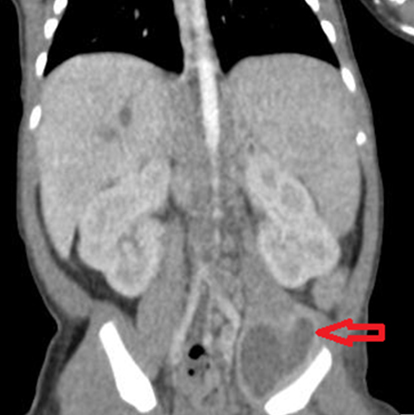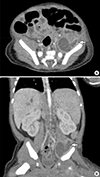1. Mynter H. Acute psoitis. Buffalo Med Surg J. 1881; 21:202–210.
2. Okada Y, Yamataka A, Ogasawara Y, Matsubara K, Watanabe T, Lane GJ, Miyano T. Ilio-psoas abscess caused by methicillin-resistant Staphylococcus aureus (MRSA): a rare but potentially dangerous condition in neonates. Pediatr Surg Int. 2004; 20:73–74.
3. Yano T, Takamatsu H, Noguchi H, Tahara H, Kaji T, Saruwatari Y, Sakai I. Iliopsoas abscess in the neonate. J Pediatr Surg. 2004; 39:e13–e15.
4. Horiuchi A, Kameoka K, Kuwabara J, Watanabe Y, Kawakami S, Tauchi H, Ishii E. Neonatal iliopsoas abscess. Pediatr Int. 2012; 54:712–714.
5. Edgar KA, Schlesinger AE, Royster RM, Deeney VF. Ilio-psoas abscess in neonates. Pediatr Radiol. 1993; 23:51–52.
6. Natsume H, Nakanishi T, Nakagawa Y, Igarashi Y. A case of an iliopsoas abscess in a neonate. Acta Paediatr Jpn. 1997; 39:459–461.
7. Andreou A, Karasavvidou A, Papadopoulou F, Koukoulidis A. Ilio-psoas abscess in a neonate. Am J Perinatol. 1997; 14:519–521.
8. Prassopoulos PK, Giannakopoulou CA, Apostolaki EG, Charoulakis NZ, Gourtsoyiannis NC. Primary ilio-psoas abscess extending to the thigh in a neonate: US, CT and MR findings. Pediatr Radiol. 1998; 28:605–607.
9. Dib M, Bedu A, Garel C, Mazda K, Philippe-Chomette P, Rajguru M, Hassan M, Aujard Y. Ilio-psoas abscess in neonates: treatment by ultrasound-guided percutaneous drainage. Pediatr Radiol. 2000; 30:677–680.
10. Vastyan AM, MacKinnon EA. Primary psoas abscess in a neonate. Am J Perinatol. 2006; 23:253–254.
11. Okan F, Ince Z, Coban A, Can G. Neonatal psoas abscess simulating septic arthritis of the hip: a case report and review of the literature. Turk J Pediatr. 2009; 51:389–391.
12. Sham M, Singh D. Neonatal ilio-psoas abscess: report of two cases. J Neonatal Surg. 2014; 3:4.
13. Sedaghatian MR, Barkhordar J, Gerami S. Retroperitoneal abscess presenting as an abdominal mass in neonate. J Pediatr Surg. 1978; 13:544–545.
14. Zych GA, McCollough NC. Acute psoas abscess in a newborn infant. J Pediatr Orthop. 1985; 5:89–91.
15. Schut JM, Meradji M, Oranje AP, Bergmeijer JH, Schuller JL. Double-sided psoas abscess in a young infant: sonographic and radiographic findings. Pediatr Radiol. 1988; 18:176–177.
16. Singer J. Neonatal psoas pyomyositis simulating pyarthrosis of the hip. Pediatr Emerg Care. 1993; 9:87–89.
17. Lucas AP, Carneiro R, Viegas M, Pascoal J, Sousa-Santos A. Ilio-psoas abscess in the neonate. Eur J Pediatr Surg. 1997; 7:186–187.
18. Al-Zaiem MM, Bajuifer SJ, Fattani MO, Al-Zaiem FM. Bilateral iliopsoas abscess associated with right hip septic arthritis in a neonate. Saudi Med J. 2014; 35:743–746.
19. Adelekan MO, Taiwo SS, Onile BA. A review of psoas abscess. Afr J Clin Exp Microbiol. 2004; 5:55–63.
20. Shields D, Robinson P, Crowley TP. Iliopsoas abscess: a review and update on the literature. Int J Surg. 2012; 10:466–469.










 PDF
PDF ePub
ePub Citation
Citation Print
Print




 XML Download
XML Download